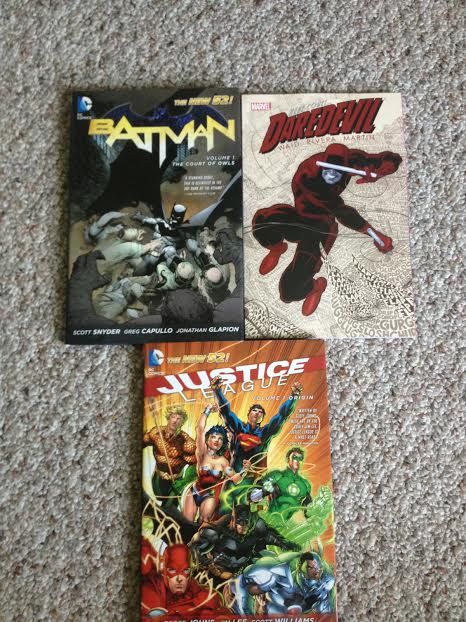Comic Books: Where to start and what to buy
With Marvel’s “Age of Ultron” now in theaters (and getting an A- from the Oakland Post), and the “Batman v Superman: Dawn of Justice” trailer having been released only a week ago; superhero hype seems to be higher than ever.
With the success of both superhero films and TV shows- “Arrow” and “Daredevil” to name a few- more and more people have found themselves searching for new means to get that Avengers-vibe. Inevitably, those interested will come to the same conclusion, the birthplace of all these modern-day Greek gods: comic books.
Comic books are a beast in its own right. They have multiple publishing houses, each with a variety of titles, genres, and characters that can make it overwhelming to those uninitiated beyond the movies, games and shows.
DC Comics and Marvel Entertainment are the ‘big-two’ in the superhero world, and are the most well-known companies among fans. DC having Batman, Superman, and Wonder Woman, and Marvel having Spider-Man, X-Men, and the Avengers, they are the highest earners of these publishing houses. However, even with the narrowing down to just these two publishers, it can still be daunting to those hoping to get into the world of comics.
Where to start
With the movies, games, and TV shows in mind, many people always seem to know where to begin. “Batman,” for example, is a character many are interested in currently, having been shown on the big-screen not too long ago in “The Dark Knight” trilogy, and will be soon depicted by Ben Affleck in the upcoming “BvS” film.
So, now that we have a character, Batman and his publishing house DC Comics, one can dive into the city of Gotham.
Now, Batman has a history of over 75-years of storylines and books, and the process of wading through these many years can be overwhelming. Luckily, there are plenty of storylines that can help new readers begin.
“The New 52” and “Marvel Now”
Back in 2011, DC Comics initiated a new line of comics titled, “The New 52,” which rebooted their entire line of comics from issues #700+ all the way back to #1. This gave readers a new chance to dive headfirst into these characters for the first time.
Marvel Entertainment then preformed a similar process with their characters, under the banner of “Marvel Now,” bringing them all back to #1’s in 2012. This provided new readers with an open opportunity to go into these different worlds without having to know any backstory other than the characters names.
Regardless of the fact that both of these reboots in these publishers comic-line happened four years ago, all these stories are still canon, meaning that they are still the same worlds that began four years ago. This means that any new reader can begin reading these books right away and catch up to modern continuity and their story-arcs: a self-contained story under any given title, amongst which there are many. When one story-arc ends, another begins, without any break in issue numbering.
Other places to start
“The New 52” and “Marvel Now” aren’t the only ways to get into comics, however, nor are they the only jumping-on points. There are multiple stories that are intros and beginnings of story-arcs that came long before either “52” or “Now.”
To name a few.
Sometimes getting into comics is a gamble and you have to be brave and jump right in. Luckily, to help with this daunting task, there are many ways to both read and find comics that will help a new reader dive in.
How to read/get comics
There are multiple ways to both read and purchase comic books:
How to read
There are two types of both reading and collecting comics: single issues and trade paperbacks/graphic novels. Both single issues and trades/novels will give a new reader all of the content in a story-arc for any given character or team.
Single issues are the individual magazines of any given comic character, which contain a single chapter of any given story-arc. These are the comics that are most notably bought for collectability, potential for increased value after some time, and are the fastest way to read a brand-new story-arc. Single issues have many pros and cons to them, though, each issue being produced a whole month after the previous issue is released, resulting in wait times that force collectors to re-read multiple issues to understand what is going on when the next issue finally hits the stands.
Reading this way also doesn’t guarantee that you will pick up every chapter of any given story, because everyone is out to buy the same issue, and getting any #1’s from any store can range from being difficult to absolutely impossible. However, singles do supply readers with anticipation and cliffhangers that are not presented in the trade/novel format. Single issues range from $2.99-$4.99 normally, depending on the character, publisher and story-arc.
Trade paperbacks/graphic novels are the collected editions of a story-arc or character. This is the easiest form of reading comics, because there is no wait for a next chapter of a story-arc and there’s no worry that you will miss an issue of the series you are reading. Trades/novels are printed around six months after any given story-arc is completed in the single comic format, so the wait for the next story-arc is longer than in single form.
Trades/novels tend to range from $10-$50, with $15-$20 being the norm for soft-covers, and $25-$35 being the norm for hardbacks, although it depends on the character, publisher, and story-arc. (DC tends to be about $5-$15 cheaper than Marvel books).
How to purchase
There are endless means to purchase comic books, but there are three main ways that any new comic reader should be familiar with: comic shops, digital comics, and good ol’ Amazon.com.
-Comic shops are ideal for new readers who are still very nervous as to how to begin reading. Shop workers can lead new readers into the directions they need to go while also helping them to navigate into this new world. This is also the prime place to buy physical single issues. It is also important to note that comic shops help keep comic companies up-and-running, so any purchase at a comic shop helps to support the comic industry.
*Comic City, in Pontiac MI, is one such shop new readers can visit to get into comics. The men and women who work there are extremely helpful and kind, and can be guiding hands into this new world. This is the closest comic shop to Oakland University, and the shop I personally go to. For more shops around you, click here.
-Digital comics are perhaps the easiest way to buy comics, as they offer both single issues (of which they have every issue uploaded at all times so that readers won’t ever miss an issue) and trades/novels, usually at a discount of their physical counterparts.
-Amazon.com is the cheapest way to buy comics, all books usually at discounted prices from the comic stores, while also providing readers with reviews of each book.
Recommendations
As college students; there is gas, food, and rent to pay, and bills that are endless in form. So, it can be difficult to get into comics. As far as recommendations go; it is easiest to begin with either “The New 52” and “Marvel Now,” learn the ropes and branch out beyond “52” and “Now” when a new reader gets the hang of how they will read their books. And, as such, it is easiest to first purchase a trade paperback/graphic novel version(s) to begin any one’s collection, preferably via Amazon.com, as it is the cheapest way to begin reading. As far as the best from “52” and “Now” is concerned:
–The Amazing Spider-Man: The Parker Luck
–The Avengers: Avenger’s World
These are all great ways/ stories for any new reader to begin with.
Overall, getting into comics is an experience worth jumping into, with stories that are rewarding and personal and cannot be found in any other medium in the same way. Once a new reader turns that first page; personally, I have never turned away since.




